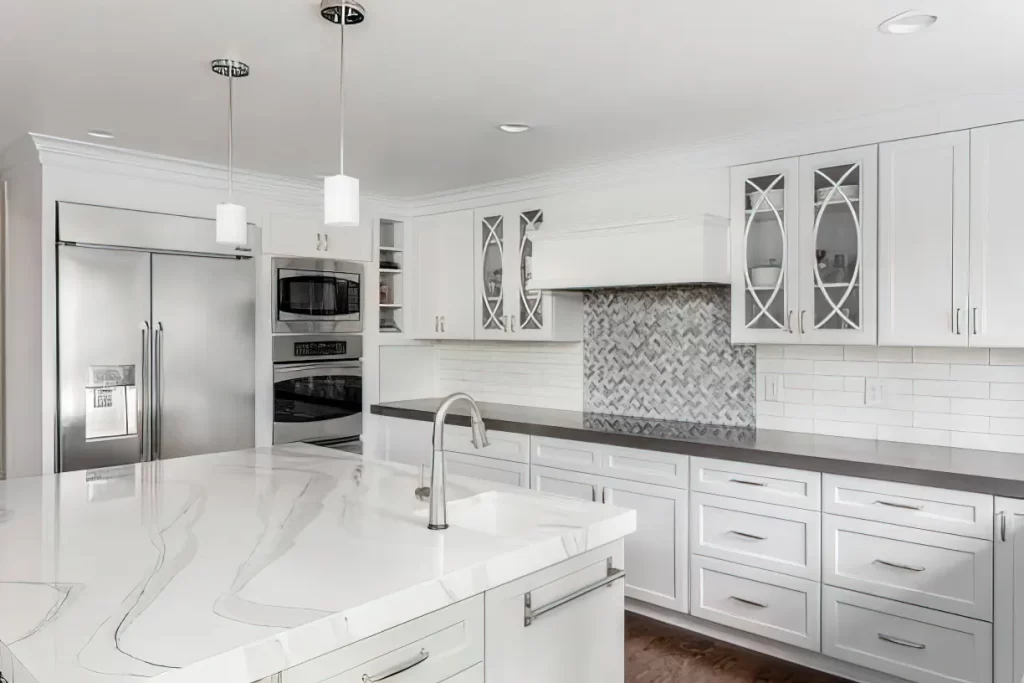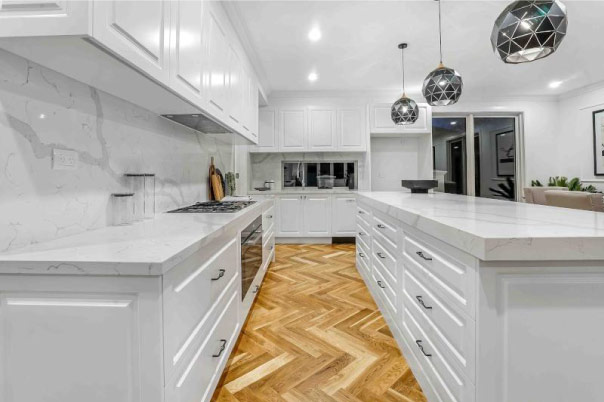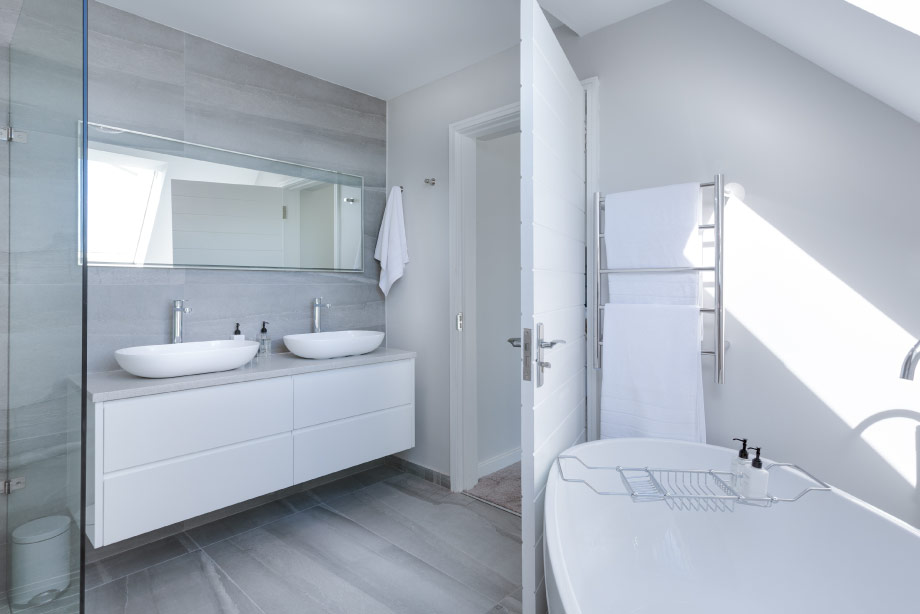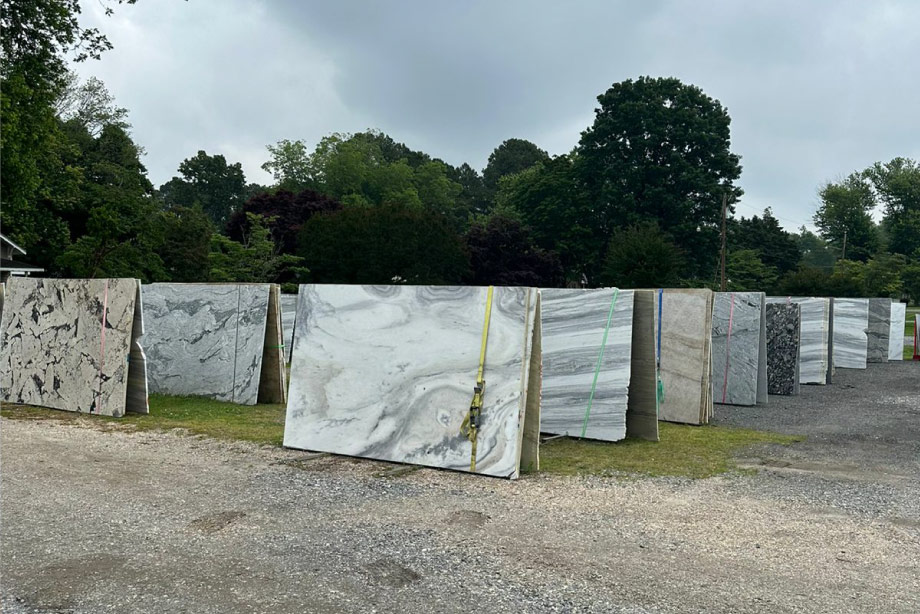Vinyl flooring can indeed be quite perplexing. With an array of options, ranging from Luxury Vinyl Planks (LVP) to vinyl sheets, navigating this realm can be overwhelming. However, fear not, as we’re here to lend a hand!
While you might already possess some knowledge about vinyl flooring, there are likely a few lingering queries in your mind. The good news? We’ve got the answers. We’ve curated a list of our most frequently asked questions to simplify your shopping journey.
So, let’s dive right in!
Frequently Asked Questions About Vinyl Flooring
The Basics: What is Vinyl Flooring?
There are so many kinds of vinyl flooring: waterproof, peel and stick, sheet vinyl, and then all those acronyms. LVF, SPC, WPC. It can start to look like a jumble of alphabet soup. Let’s start with the basics so you know more about your options.
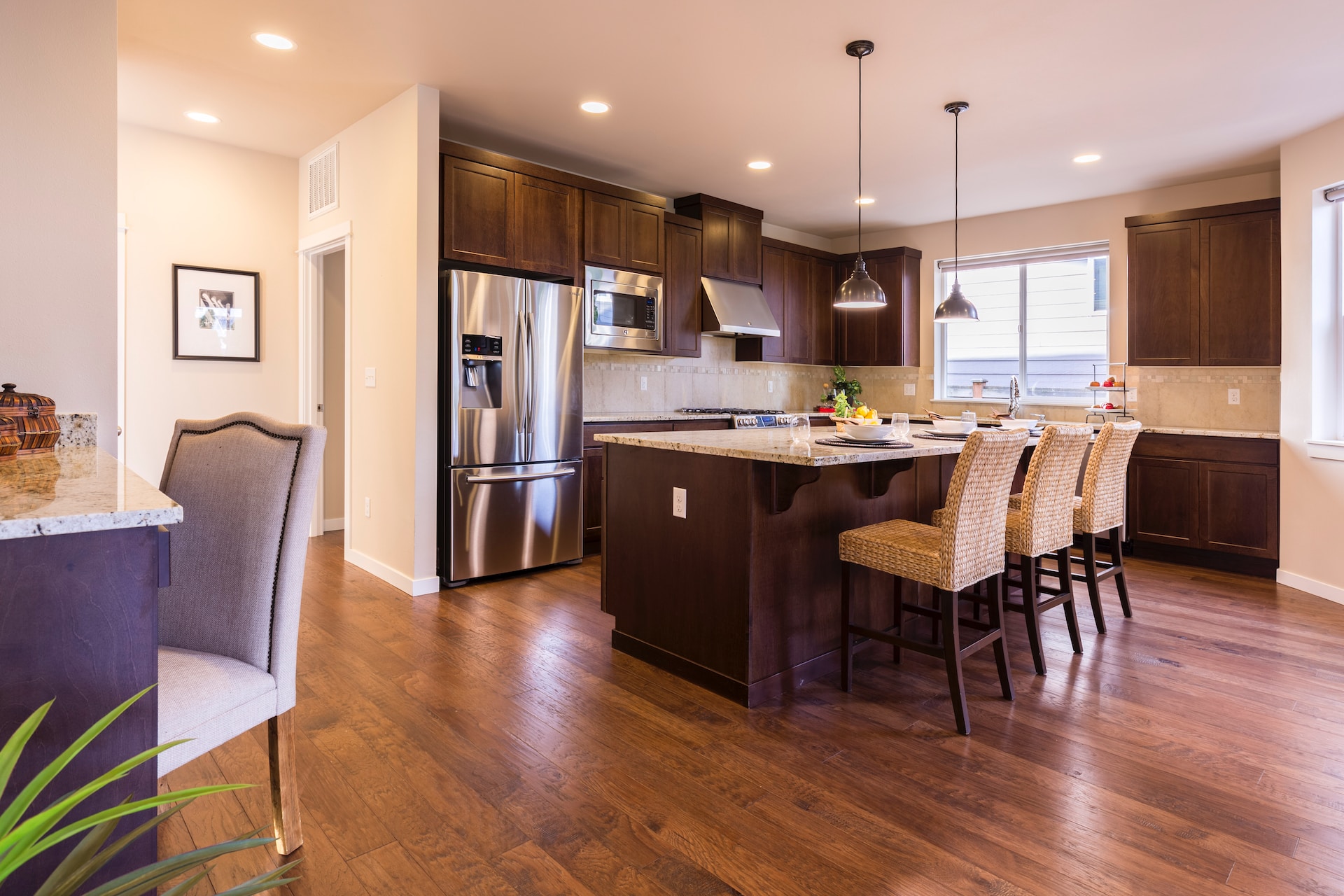
WPC, LVF, and SPC: Decoding Vinyl Flooring Types
Vinyl flooring comes in various types: waterproof, peel and stick, sheet vinyl, and a slew of acronyms like LVF, SPC, and WPC. It might appear as a confusing alphabet soup, but let’s break down the basics to help you understand your options better.
What is WPC Vinyl?
WPC stands for Wood-Plastic Composite Vinyl, but it’s also known as Waterproof Core Vinyl Flooring. Both terms are accurate. WPC vinyl is 100% waterproof, featuring a core made from a blend of plastic and wood. In the flooring industry, it’s often referred to as Engineered Vinyl Flooring. It’s recommended for residential use due to its softer feel underfoot.
Can you explain SPC Vinyl?
SPC stands for Stone-Plastic Composite or Stone-Polymer Composite, used interchangeably. It’s sometimes called Rigid Core Luxury Vinyl Flooring because of its ultra-dense stone-plastic composite core. Like WPC, SPC is 100% waterproof and is also considered Engineered Vinyl Flooring. It’s suitable for both residential and commercial spaces.
Define LVF Vinyl?
LVF stands for Luxury Vinyl Flooring, serving as an umbrella term that often includes WPC and SPC. LVF can also refer to vinyl that’s not waterproof or doesn’t have a rigid core. It typically features high-quality visuals and may have a basic glue-down or lock installation mechanism.
What exactly is LVP Flooring?
LVP stands for Luxury Vinyl Planks, designed to be exceptionally durable, capable of withstanding high traffic, children, and pets. Standard LVP comprises a vinyl core with a printed surface layer. It might include an attached underlayment and can be either glued down or floated with a locking mechanism. Some LVPs are waterproof, featuring WPC or SPC cores.
What precisely i LVT Flooring?
LVT stands for Luxury Vinyl Tiles, offering top-notch durability and style. These tiles are well-suited for busy homes with pets and heavy foot traffic. They feature high-quality, stone-look visuals and, in some cases, realistic textures. Premium LVT products may include waterproof cores, attached underlayment, and a thick wear layer, although not all products have these features.
What is Vinyl Sheet Flooring?
Vinyl sheet flooring is a multi-layer, durable option that’s easy to install and maintain. It consists of a wear layer and a protective layer to guard against scuffs and scratches, similar to vinyl planks and tiles. Modern vinyl sheets, often reinforced with fiberglass, lie flat and resist curling. They can be loose-laid or installed with double-sided adhesive tape, avoiding the need for a complex glue-down installation. Luxury vinyl sheets offer a wide range of stylish looks, including realistic wood and contemporary designs, all at an affordable price.
Are Vinyl Flooring and Linoleum the Same?
Vinyl and linoleum flooring are distinct materials with key differences. While sheet vinyl used to resemble linoleum, the two are not interchangeable.
Linoleum:
- Made from natural materials
- Anti-microbial properties
- Anti-static properties
- Requires annual sealing
- Professional installation recommended
Luxury Vinyl Flooring:
- Crafted from durable PVC
- Features a protective wear layer
- Offers backing options like fiberglass, foam, or felt
- DIY-friendly installation
- Virtually maintenance-free
To explore the full range of vinyl flooring options, visit KBS HomeCenter’s extensive collection.
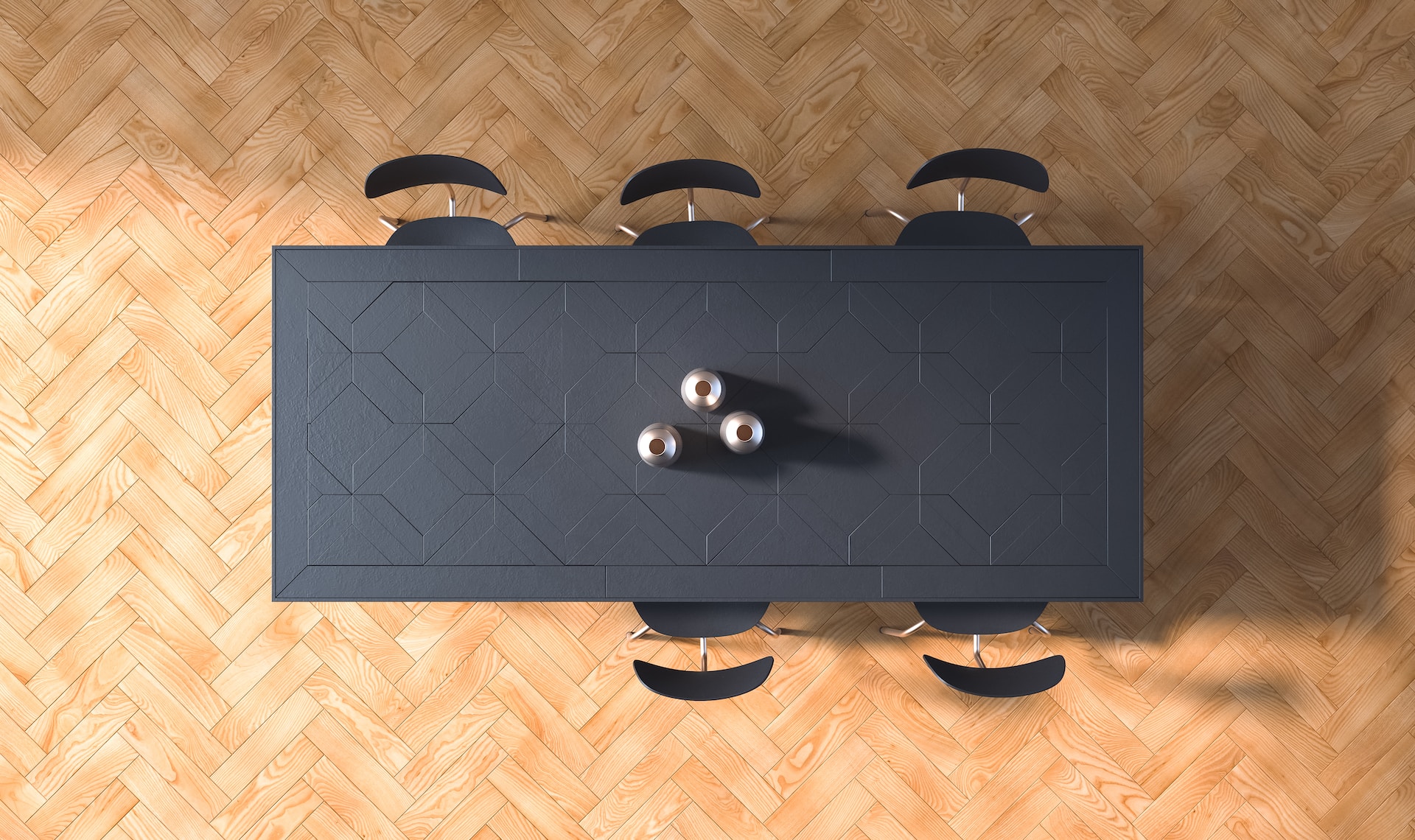
Use and Durability
Can I put heavy appliances down directly on my vinyl floors?
You can put heavy appliances on vinyl tiles and planks as long as you use furniture pads or sliders under them. However, you should not install heavy appliances over loose laid sheet vinyl, because this could cause a pinch point and damage the floor.For furniture, you should use felt furniture pads under the legs to prevent scratching the flooring. Never use rubber, as rubber can stain vinyl flooring.
You can also put most vinyl flooring under kitchen cabinets and appliances, but it’s a good idea to glue down those sections.
Do I need a protector on my vinyl floor for my rolling desk chair?
Even though vinyl flooring has a tough wear layer, it’s a good idea to use a mat under desk chairs. Over time, rolling desk chairs might cause some wear and tear. It’s better to be safe than sorry!Can I put vinyl flooring in my basement?
All vinyl flooring can be installed in basements, though some options will be more difficult to install. For example, a vinyl sheet that needs to be glued down will take more effort than a click-lock vinyl plank. You’ll need to make sure the cement subfloor is completely level, or thin flooring like sheet vinyl could show the imperfections through the surface and actually become damaged over time.DIY-friendly waterproof vinyl flooring, like TritonCORE Pro, is a great option in basements. It can generally be installed in moisture-prone areas and even over uneven subfloors. If you’re installing waterproof vinyl flooring over basement concrete, we recommend adding a vapor barrier underneath.

How to Install Vinyl Plank Flooring
Many luxury vinyl planks and tiles utilize a tongue and groove locking system, often referred to as a click-lock flooring system, making it a DIY-friendly installation. No need for tape, glue, or professional assistance! This method creates what’s known as a floating floor because it essentially “floats” over your subfloor.
Here’s a step-by-step guide on how to install interlocking vinyl flooring, suitable for both planks and tiles:
Start in a Corner: Initiate the installation in a corner of the room, progressing from left to right. Begin by placing the first plank (or tile) with spacers to maintain a 3/8” gap between the flooring and the wall. This gap allows the floor to expand and contract with temperature fluctuations.
Complete the First Row: Insert the tongue of the second plank into the groove of the first at an angle. Once they click together, lower the second plank until it’s flat. A tapping block and rubber mallet can be used to gently tap the planks into a locked position.
Continue Rows: Repeat this process until the first row is complete. When you reach the wall and need to cut a plank, measure it, and use a utility knife or tile cutter for cutting.
Begin the Next Row: Start the next row with the leftover cut end, provided it’s at least 6” long, for a staggered appearance.
Interlock Planks: Ensure the plank in the next row slides into place and interlocks correctly by setting it at a slight angle.
Complete Installation: Continue across the room, ensuring tight interlocking of the planks. Use spacers around the flooring’s edges every few feet, removing them once the installation is finished.
How to Install Fiberglass Vinyl Sheet Flooring
Fiberglass vinyl sheets can be installed using the loose lay method, which doesn’t require adhesive. This approach is DIY-friendly and ideal for temporary flooring or low-traffic areas.
Here’s a straightforward guide to loose laying vinyl sheet:
Unroll the Sheet: Unroll the vinyl sheet and align the seams if using multiple sheets. Ensure it’s square to the room.
Acclimate the Sheet: Allow the sheet to acclimate to the room’s temperature and humidity for at least a day before cutting.
Cutting: Use a utility knife to cut around walls and obstacles, leaving a 1/8” – 1/4” gap to accommodate potential expansion due to temperature changes.
Optional Stability: For added stability, apply double-sided tape around the perimeter and under seams. Note that this method allows for only one major seam. Larger spaces requiring more than two sheets will need gluing for added support.
It’s worth mentioning that this installation isn’t suitable for high-traffic areas. In commercial spaces expecting heavy foot traffic, sheet vinyl should be glued down.
How to Cut Vinyl Flooring
The method for cutting luxury vinyl flooring varies based on the type:
Cutting Vinyl Plank Flooring: LVP or WPC vinyl flooring can be cut by scoring it with a sharp utility knife and snapping it for a clean break. SPC vinyl flooring can be cut using a power saw or a tile cutter, depending on your preference.
Cutting Vinyl Sheet Flooring: To cut vinyl sheet flooring, use a sharp utility knife and a straight edge as a guide. Ensure the sheet is square to the room before making any cuts. Maintain a 1/8” – 1/4” expansion gap around the edges and obstacles like columns.
Which Direction to Install Vinyl Plank Flooring?
When installing vinyl planks, it’s advisable to align the length of the planks parallel to the longest walls in the room. This creates an illusion of more space. In square-shaped rooms, arrange the planks to follow the flow of traffic.
Can Vinyl Planks or Tiles Be Installed Over Radiant Heat?
Yes, most vinyl planks and tiles are compatible with radiant heat systems. However, always consult the manufacturer’s instructions before installation to ensure compatibility and avoid any potential issues.
For all your flooring needs and installation advice, remember to consult KBS HomeCenter.

Visit our showroom in Virginia or give us a call at 804-435-1122 to discuss your project requirements and discover the endless possibilities for enhancing your home with our premium products and top-notch services. You can also reach us via email at kbs@kbshomecenter.com. Let KBS HomeCenter be your partner in creating the home of your dreams.
Contact us
Visit our showroom in Virginia or give us a call at 804-435-1122 to discuss your project requirements and discover the endless possibilities for enhancing your home with our premium products and top-notch services. You can also reach us via email at kbs@kbshomecenter.com. Let KBS HomeCenter be your partner in creating the home of your dreams.
Tappahannock, Virginia
- 221 S Church Ln, Tappahannock, VA 22560
- 804-435-1122
Kilmarnock, Virginia
- 420 S Main St, Kilmarnock, VA 22482
- 804-435-1122
Home Improvement Store in Kilmarnock and Tappahannock, Virginia

How can we help you?
Ready to transform your space? Contact us now and start the journey to the home of your dreams. We're here to assist every step of the way.
Frequently Asked Questions About Vinyl Flooring: Your Comprehensive Guide
Vinyl flooring can indeed be quite perplexing. With an array of options, ranging from Luxury Vinyl Planks (LVP) to vinyl sheets, navigating this realm can be overwhelming. However, fear not,…
Elevate Your Space with Inspired Floors for Modern Living
When it comes to transforming your living space into a haven of modern comfort and style, every detail matters. One often underestimated yet crucial aspect of interior design is the…
Understanding the Impact of Lighting on Flooring: Key Considerations Before Your Purchase
Selecting the right flooring material for your home is not just about quality and style; it’s also about color. However, what many overlook is how the floor color can appear…
5 Kitchen Remodel Ideas On A Budget
Starting a new home remodeling project can be quite challenging, especially if you’re on a budget. Kitchen remodeling, in particular, can be a significant test of your financial planning skills.…
Advantages of Granite Countertops – Elevate Your Kitchen’s Beauty and Durability
When it comes to selecting the perfect material for your kitchen countertops, granite stands out as an exceptional choice. This natural stone not only enhances the aesthetics of your kitchen…
Why Invest in a Marble Countertop? Discover the Benefits of Marble Countertops
When it comes to selecting the perfect kitchen countertop, the benefits of a marble countertop are undeniable. Quality materials are essential, and among the top choices, marble stands out as…
Choosing Quartz for Countertops: A Smart Decision
When it comes to selecting the ideal material for your countertops, you might feel overwhelmed by the multitude of choices. It’s crucial to take your time, ensuring that the material…
Should White Cabinets Match Walls? Expert Insights from KBS HomeCenter in Virginia
Are you considering a kitchen makeover and seeking advice on paint color selection? A common query is whether white cabinets should precisely match white walls. In reality, there’s no definitive…
Kitchen Renovation in Virginia: What Comes First Floors Or Cabinets?
When embarking on a kitchen renovation in Virginia, the process is much like orchestrating a symphony of design elements. Achieving a balance between visual appeal and functionality is paramount, and…
14 Bathroom Counter Organization Ideas
Did you know that individuals spend an average of about half an hour daily preparing in their bathrooms? That equates to over 182 hours spent annually in this compact space.…
The Best Countertop Options for Kitchens and Bathrooms in Virginia
When considering a kitchen remodel or bathroom remodel, you’re faced with a multitude of choices for selecting the perfect countertop. Every material presents its own advantages and disadvantages, making the…
Bathroom Renovation Guide for Virginia
Are you planning a bathroom renovation in Virginia? Look no further! Our team at KBS HomeCenter has gathered expert tips to help you optimize your bathroom remodel. From creating a…
StoneCenter from KBS HomeCenter: The Perfect Choice for Stone in Virginia
At StoneCenter from KBS HomeCenter, you will find an extensive selection of exquisite stones to elevate the beauty and functionality of your living spaces. Our showroom… StoneCenter from KBS HomeCenter:…





